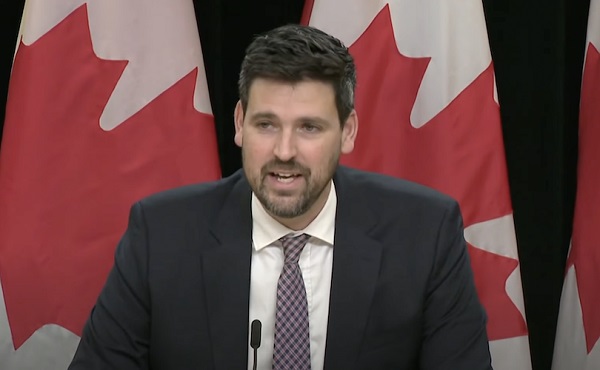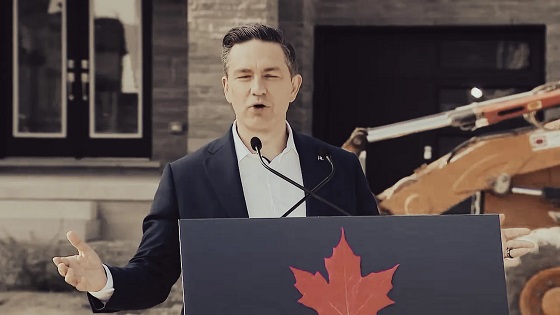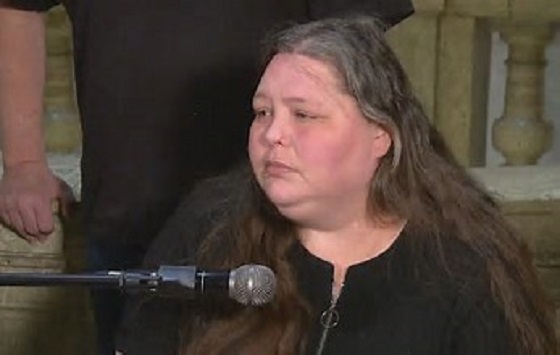Immigration
ISIS and its violent Central Asian chapter are threatening Canada and the West with jihad. Hussain Ehsani for Inside Policy

From the Macdonald Laurier Institute
By Hussain Ehsani
Recent terrorism-related arrests in Canada and the wider West are evidence of the resurgence of ISIS, and especially its ultra-violent Afghanistan wing… recently revealed internal memos by Canada’s Integrated Terrorism Assessment Centre (ITAC) highlighted ISIS’s growing role in inspiring domestic terrorism
Ten years ago, the Islamic State of Iraq and Syria waged a holy war that threatened to engulf the wider Middle East. At its peak, ISIS conquered nearly 200,000-square-kilometres of Iraq and Syria, inspiring thousands of jihadis to join its crusade against the West.
It took a global coalition of 87 nations and groups, led by the United States and including Canada, to defeat Daesh for good. By December 2017, the damage was decisive: ISIS had lost more than 95 per cent of its territory. The coalition members celebrated the defeat of ISIS and thought it could no longer pose a threat, in the Middle East or anywhere else.
The moment lasted only a short time.
Recent terrorism-related arrests in Canada and the wider West are evidence of the resurgence of ISIS, and especially its ultra-violent Afghanistan wing. At the same time, recently revealed internal memos by Canada’s Integrated Terrorism Assessment Centre (ITAC) highlighted ISIS’s growing role in inspiring domestic terrorism, and in particular, potential “lone Wolf” attacks against Canada’s Jewish community.
The memos – issued on June 24 and July 10, 2024, and later obtained by media – were prescient: On July 31, Canadian police detained two alleged ISIS-affiliated men in Richmond Hill, Toronto, apparently based on a tip from French intelligence. In September, the RCMP in Quebec – working with the FBI – arrested a Pakistani national on a student visa for allegedly plotting an attack on a Jewish centre in Brooklyn, New York. These events were especially shocking since it was widely believed that ISIS was confined to Iraq and Syria. But ISIS is clearly influencing a new generation of terrorists around the world. Indeed, it’s suspected that ISIS inspired, and possibly directed, a plot to attack the Jewish community in Ottawa last February. Police arrested two Ottawa youths in relation to the alleged plot and charged them with attempted murder.
American authorities have also thwarted ISIS schemes, resulting in the arrest of ISIS-Tajiki operatives in the US earlier this year. The arrests continue: On October 7, the FBI apprehended an Afghan national and a juvenile co-conspirator for allegedly planning an attack under the Islamic State banner on November 5 – the day of the US presidential elections.
These US arrests point to a new trend: the rise and global reach of the Afghan branch of ISIS, known as the Islamic State-Khorasan Province (ISKP). Some background is necessary. ISIS officially emerged in 2014, following rapid territorial gains in eastern Syria and northwestern Iraq. Rooted in the ideology of Salafi Jihadism, ISIS sought to establish a “Caliphate” governed by a strict interpretation of Sharia law. The group declared its leader, Abu Bakr al-Baghdadi, as Caliph in June 2014 after capturing Mosul, Iraq’s second-largest city. This marked the height of ISIS’s power, controlling large swaths of Syria and Iraq.
As ISIS entrenched itself, it began expanding its influence beyond Iraq and Syria. Various affiliates, known as “provinces” or “wilayat,” emerged worldwide. Pledging allegiance to the central ISIS leadership, these groups dedicated themselves to establishing a global Islamic State.
That is one reason for the group’s resilience and recent resurgence. The ISKP was one of the most deadly branches to emerge. Founded in southeastern Afghanistan in 2015 on the border with Pakistan, ISKP immediately sought closer ties with the core ISIS group in Syria and Iraq to gain legitimacy and embolden its fighters and middle-rank commanders to conquer more territory. Those efforts came up short, and ISKP failed in its first years to win ISIS’s support.
Since then, ISKP has redoubled its efforts to impress its ISIS masters – and in many ways, it has succeeded. The group is now among the strongest of ISIS’s adherents.
Turning Point
The collapse of the former Afghan Government on August 15, 2021, was the turning point, when a host of transnational extremist fighters were released from prisons of Afghanistan. Aside from rejoicing about the withdrawal of foreign troops from Afghanistan, they prepared to take up their “holy duty” to expand ISIS’s regime. ISKP initially in 2015 drew its fighters from disaffected and wayward elements of the Taliban, Haqqani network, and Pakistani Taliban. The release of an additional cohort of Salafists (Sunni fundamentalists) aided its recruitment.
ISKP moved quickly to expand its influence and operations. The first attack in this new era was devastating: it stormed the Abbey Gate of the Kabul Airport on August 26, 2021, killing 170 Afghan civilians and 13 US soldiers. The US Department of Defense later released a report that Abdul Rahman al-Logari, one of the prisoners released on the day of Kabul collapse, was behind the Abbey Gate attack.
The message was clear – ISKP was on the march.
ISKP on the International Stage
To gain “formal” admission to the ranks of ISIS’s provinces, ISKP would have to show initiative and capability, not just in Afghanistan but in the wider territory of Khorasan: Iran, Tajikistan, Uzbekistan, and the eastern part of Turkmenistan.
To do so, it had to find new targets. Traditionally, the Hazara community, the most persecuted ethnicity in Afghanistan, was the main target for Islamist groups, along with former Afghan security forces. They remain primary victims. However, ISKP’s range of targets and ability to strike them has grown. It added new targets in Afghanistan, attacking the Russian embassy in Kabul in September 2022, and a Chinese facility in December of the same year. Then it started reaching beyond the borders of Afghanistan: ISKP has carried out terrorist attacks in Central Asia and plotted a number of them in Pakistan.
Targets even farther away have now been hit. In January 2024, ISKP executed a complex attack in Kerman, Iran, at an event commemorating Qasem Sulaimani, the former commander of the Iranian Islamic Revolutionary Guard Corps (IRGC) Qods Force, killed by US forces in 2020. On March 22, 2024, it hit a concert hall in Moscow – an operation that took the international community by complete surprise.
These operational successes mattered, but ISIS’s core leaders in Syria and Iraq demanded signs of ideological subservience as well. Under the leadership of Sanaullah Ghafari (also known as Dr. Shahab al-Muhajir), ISKP worked hard to prove that its propaganda machine is an engine of ISIS Salafist ideology.
ISKP uses fluency in a variety of languages, including Urdu, Russian, Tajiki, Uzbeki, Turkish, English, and Pashto, to spread its message. It seeks to extend its ideology to other fighters in the region in order to recruit transnational Salafi Jihadists. It has already recruited a vast number of terrorists from the ranks of the Islamic Movement of Uzbekistan in the north of Afghanistan. ISKP also exploited propaganda and demand from the diaspora of Uzbekistan and Tajikistan to plot attacks against Western countries.
The attacks and ideological efforts seem to have worked. ISKP now appears to have become the operational wing of the core ISIS group. After the ISKP attack on Moscow, an ISIS spokesman released a 41-minute audio message praising the attack by “Mujahidin” and called on other “dormant” provinces of the “Caliphate” to rise up and follow ISKP’s example.
The terror spreads
ISIS leader Abu Hafs al-Hashimi al-Quraishi has more work in mind for his prized ISKP group. His priorities include freeing jihadists detained in Syria and attacking targets in Europe and North America.
In Syria, Al-Quraishi has encouraged ISIS terrorists to redouble efforts to attack the Syrian Democratic Forces, a US-backed Kurdish militia in the country’s northeast, and try to break detained comrades out of SDF-run prisons. These facilities host thousands of ISIS fighters, including women and children. Given the success of ISKP’s operations and recruitment, ISIS is likely trying to implement the same tactic of jailbreaks in Kurdish territory in Syria and Iraq, to replenish its ranks.
ISIS spokesmen have also called for all Muslims to attack Christians and Jews in the broader West.
In September 2024, Türkiye’s domestic security agency (MIT) arrested Abuzar Al Shishani, who allegedly was plotting an attack on Santa Maria Italian Church in Istanbul in early January 2025. According to MIT, ISKP recruited him in 2021. The arrests in Canada, the US, and Türkiye are proof that ISKP’s reach is growing.
How can Canada fight back?
Canada and its allies in the West must act now to counter the terrorist threat posed by ISKP and ISIS. Fortunately, the RCMP and other Canadian police forces halted the recent spate of planned domestic terror attacks. However, stringent immigration screening is also crucial to keeping Canada and its allies safe. The Canada Border Services Agency needs to be ready to deal with the ISIS/ISKP threat.
To that end, Public Safety Canada should examine ways to enhance inter-agency targeting and intelligence sharing. A task force consisting of Immigration, Refugee and Citizenship Canada, Canadian Heritage, the Canadian Revenue Agency, and FINTRAC – given their respective roles in immigration processing, countering disinformation and anti-terrorist financing – could help to ensure maximum coordination against the group.
Canada must also guard against the threat ISKP/ISIS poses to religious and minority communities in the country. ISIS’s call to target Jewish and Christian communities presents a special challenge. The Jewish community is particularly vulnerable due to the rampant antisemitism seen at pro-Hamas, Hezbollah, and Iran rallies across Canada. But Christian sites, like churches, are also vulnerable. ISKP/ISIS are also likely to target Muslim groups that speak against its violent ideology.
Canada should collaborate with international partners to support communities and groups opposed to ISKP/ISIS. These include the Hazara, Kurdish, and Yazidi communities in Afghanistan and Kurdistan, as well as allies in the Kurdistan Regional government, and the Syrian Democratic Forces. Canada should also support initiatives led by the Kingdom of Saudi Arabia and other Gulf Cooperation Council countries to strengthen the voice of moderate Islam in the Middle East and Central Asia. Such initiatives require careful diplomacy with allies and a range of partners. That is what Canada will require to counter the evolving threat of ISIS and ISKP.
Hussain Ehsani is a Middle East affairs analyst with expertise on the Islamic State and al-Qaeda in Iraq and Afghanistan. He is currently exploring the foreign policy relationship between Saudi Arabia and Canada. In addition to MLI, he also contributes to the Jerusalem Post, BBC Persian, and The Hill.
Immigration
Conservatives blame Liberals for allowing man on UK child sex offender list to enter Canada

From LifeSiteNews
A Pakistani man was granted a visa in 2023 under former Prime Minister Justin Trudeau’s government after hiding that he was found guilty of sexually abusing his underage niece.
Canada’s Conservative Party blasted the federal Liberal government’s immigration department after it came to light that a Pakistani man on the U.K.’s sex-offender list was granted a visa to come to Canada
Gullfam Hussain, who was found guilty of sexually abusing his underage niece, arrived in Canada in 2023 on a visitor’s visa even though he had spent time in jail for his crimes but did not finish his sentence.
Conservative MP Michelle Rempel Garner blasted Canada’s current Justice Minister Sean Fraser, who was immigration minister in 2023 under former Prime Minister Justin Trudeau, for the gaffe.
“This is truly disgusting and is antithetical to what it means to be Canadian,” Rempel Garner noted during a question period in the House of Commons last week.
“The person who allowed this incestuous child sex abuser into Canada should be fired.”
Rempel Garner stressed that Hussain should have not been allowed into Canada in the first place.
“Why did the prime minister (Mark Carney) promote the then-immigration minister, who allowed an incestuous child sex abuser into Canada, to the minister of justice?” she asked.
According to court documents, only now are Canadian officials trying to deport Hussain for what they deemed “serious criminality and misrepresentation” because he lied on his visa application.
Records show that Hussain claimed protected person status last year, saying he was at risk of “honour crimes from his family members in Pakistan” should he be sent back to his home country. He was denied his request for protected status.
As for Fraser, he was not in the House of Commons to answer Rempel Garner’s questions. Public Safety Minister Gary Anandasangaree stated that the Canada Border Services Agency is working to ensure that criminals can’t enter Canada.
As for Hussain, Rempel Garner noted how he was put on the U.K.’s sex offender registry because he had engaged in “incestuous sex” with his young niece, who was between age 13 and 17. Hussain is 10 years older than the girl.
A court found him guilty of adult sexual activity with a minor and he was sentenced in 2017 to six years in jail. However, he was let go in 2020 and fled to Spain without serving the rest of his sentence.
Records show his niece later joined him, and they had a child in 2022 before he came to Canada in 2023.
“He did not disclose his criminal history on his Canadian visa application or upon his entry to Canada,” the court documents read.
When it comes to immigration under Trudeau and now Carney, Canada has allowed millions into the country, many from Muslim nations, including so-called LGBT “refugees,” which calls into question just how well people are being screened.
Business
Poilievre: “Carney More Irresponsible Than Trudeau” as Housing, Jobs, and Energy Failures Mount

50,000 lost manufacturing jobs, 86,000 more unemployed, soaring housing costs, and blocking every LNG project while vowing to end the TFW program
Pierre Poilievre opened his press conference with a direct attack on Mark Carney and the Liberal record on housing, framing the crisis as the product of government mismanagement rather than market forces.
He began by pointing to Conservative MP Scott Aitchison, a former mayor, as an example of what can be done when local leaders “cut the taxes and the development charges and the wait times so that building can happen.” Then came the pivot: “What a contrast with Justin Trudeau — excuse me, with Mark Carney,” he said, before slamming Carney’s choice of Gregor Robertson as housing minister. Robertson, he reminded the crowd, presided over a 149% increase in Vancouver housing costs and more than doubled homebuilding taxes. Carney, Poilievre said, rewarded that record by handing him the national housing file.
The setting itself — Deco Homes, a family-run builder founded by Italian immigrants — was chosen deliberately. Poilievre praised the Gasper family for their role in building Canada’s homes and businesses, but then asked whether such families could do the same today. His answer was no. “After a decade of Liberal taxes, Liberal spending, out-of-control Liberal immigration, reckless crime policies… the Canadian promise is really broken.”
From there, he broadened the attack. He spoke of an entire generation priced out of homeownership, of immigration growing “three times faster than housing and jobs,” of crime rising, and of what he called “the worst economy in the G7.” And then he turned squarely on Carney: “Mr. Carney is actually more irresponsible than even Justin Trudeau was,” citing an 8% increase in government spending, 37% more for consultants, and 62 billion dollars in lost investment — the largest outflow in Canadian history, according to the National Bank.
The message was simple: Liberals talk, Conservatives build. Poilievre painted Carney as a man of speeches and promises, not results. “The mistake the media is making is they’re judging him by his words rather than his deeds,” he said.
It was an opening statement designed less to introduce policy — those details came later — and more to frame the battle. For Poilievre, Carney isn’t just Trudeau’s replacement. He’s Trudeau’s sequel, and in some ways worse.
During the Q and A portion of the presser; Pierre Poilievre was pressed on immigration today, and what he said was blunt. Canada, he argued, once had the “envy of the world” system: immigrants came in at numbers the country could absorb. There were jobs, housing, health care. Everyone integrated. Ten years later? He says the Liberals have destroyed that.
The facts he used were stark. According to Poilievre, Canada is bringing in people three times faster than homes and jobs are being created. He accused the government of allowing “massive abuses” of the international student program, the Temporary Foreign Worker program, and asylum claims, with what he called “rampant fraud” right under Ottawa’s nose.
He tied this directly to the economy: youth unemployment, he said, is the worst in three decades. At the same time, employers are importing more temporary foreign workers than ever, this year at a record high and using them for cheap labor under poor conditions. His line: “While our young people can’t find jobs, employers are able to exploit temporary foreign workers by giving them lower wages and terrible working conditions.”
But here’s the part that stands out politically. Poilievre said, “Immigrants are not to blame.” He put the responsibility squarely on Liberal governments, calling their immigration numbers “reckless and irresponsible.”
His fix? End the Temporary Foreign Worker program. Cut immigration levels back to “the right numbers and the right people” to fill jobs Canadians can’t do. Tighten border standards to keep criminals out. And, in his words, “always and everywhere put Canada first.”
Pierre Poilievre didn’t hold back when asked about Mark Carney’s record. His words: “Mr. Carney is actually more irresponsible than even Justin Trudeau was.” That’s not a throwaway line, he backed it with numbers.
According to Poilievre, Carney inherited what he called a “morbidly obese government” from Trudeau and made it worse: 8% bigger overall, 37% more for consultants, and 6% more bureaucracy. He says Carney’s deficit is set to be even larger than Trudeau’s.
Then the jobs number: 86,000 more unemployed people under Carney than under Trudeau. That, Poilievre argued, is the real measure, not the polished speeches Carney gives. His line: “The mistake the media is making is they’re judging him by his words rather than his deeds.”
He also went after Carney for what hasn’t happened: “He has not approved a single major national project.” Meanwhile, Poilievre says food price inflation is even worse today, crime policy hasn’t changed the same “catch and release” approach and every big promise Carney made has already been broken.
Pierre Poilievre was asked about Ukraine, and his answer wasn’t about speeches or handshakes in Brussels. It was about pipelines.
“The best way to put Canada first while helping Ukraine is to sell our oil and gas in Europe.” His argument: Vladimir Putin bankrolls his war because Europe still buys his fuel. Poilievre said if Canada had built the Energy East pipeline, we’d be shipping a million barrels of oil a day to Europe right now.
He went further: approve LNG plants immediately, liquefy tens of billions of dollars of Canadian gas, and ship it overseas to “fully displace” Russian sales. His line: “Instead of the money going to Putin’s war machine, it will go to the trades workers in this country.”
And then the indictment of the Liberals: “Mark Carney and the Liberals have blocked every single LNG project that has been put before them. As a result, we only have one plant and it was approved by Stephen Harper.”
So the contrast is stark. Carney talks about climate virtue. Poilievre says: build pipelines, sell fuel, kill Putin’s war economy, and pay Canadian workers. His closer: “That is how you put Canada first.”
Final Thoughts
So let’s just be honest. Under Mark Carney’s leadership, the numbers aren’t just bad they’re devastating. In a matter of months, Canada has lost 50,000 manufacturing jobs. These are not low-skill jobs; they are the backbone of the economy, the kind of work that built the middle class in this country. Add to that another 86,000 unemployed overall compared to when he took office. This is what Carney calls stability.
Now, if you’re a Temporary Foreign Worker, life looks pretty good. Ottawa has built an entire system around you cheap wages, little recourse, and companies happy to import you as disposable labor. If you’re a Carney insider, it looks even better. The government is 8% bigger than when Trudeau left, consultants are raking in 37% more, the bureaucracy is swelling. It’s one of the greatest insider rackets in modern Canadian politics.
But if you’re part of Canada’s middle class, if you’re a young person trying to buy a home, if you’re a worker trying to hold onto a job in a plant, a mill, or a construction site you are being hollowed out. You’re watching your wages stagnate, your housing costs explode, your jobs disappear overseas or into government-mandated “green transitions.” And when you ask for answers, what do you get? You get Patty Hajdu telling you not to be afraid of robots. You get Mark Carney telling you his deficits are “investments.” You get speeches about “climate virtue” and “AI literacy” while your livelihood collapses.
That’s the contrast Poilievre is trying to draw. On immigration, he says: let’s end the Temporary Foreign Worker scam, bring people in at a pace we can actually house and employ, and put Canadian workers first. On energy, he says: build the pipelines, approve the LNG projects, and stop funding Putin’s war by leaving Europe dependent on Russian fuel. On the economy, he says: stop measuring success by the size of government or the smoothness of a prime minister’s speeches, and start measuring it by the number of Canadians who can work, buy homes, and raise families in their own country.
So the choice is simple. Carney offers more of the same consultants, insiders, deficits, slogans, and the slow managed decline of a once-prosperous nation. Poilievre is offering something completely different: a chance to reverse the hollowing out of the middle class and to put Canadian jobs, Canadian energy, and Canadian sovereignty first.
If you’re an insider, Carney’s Canada works just fine. If you’re a middle-class Canadian, it’s a disaster. And that, in the end, is the dividing line in this country.
-

 Bruce Dowbiggin2 days ago
Bruce Dowbiggin2 days agoWayne Gretzky’s Terrible, Awful Week.. And Soccer/ Football.
-

 espionage1 day ago
espionage1 day agoWestern Campuses Help Build China’s Digital Dragnet With U.S. Tax Funds, Study Warns
-

 Focal Points17 hours ago
Focal Points17 hours agoCommon Vaccines Linked to 38-50% Increased Risk of Dementia and Alzheimer’s
-

 Opinion1 day ago
Opinion1 day agoThe day the ‘King of rock ‘n’ roll saved the Arizona memorial
-

 Agriculture2 days ago
Agriculture2 days agoCanada’s air quality among the best in the world
-

 Automotive7 hours ago
Automotive7 hours agoThe $50 Billion Question: EVs Never Delivered What Ottawa Promised
-

 Business1 day ago
Business1 day agoCanada invests $34 million in Chinese drones now considered to be ‘high security risks’
-

 Health15 hours ago
Health15 hours agoThe Data That Doesn’t Exist








